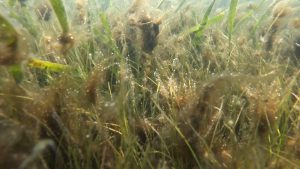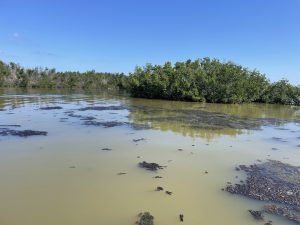In recent years, Charlotte Harbor (and the Southwest coast of Florida in general) has seen the periodic episodes of floating grey and brown carpet-like blobs. Their appearance, and the fact that they sometimes have a strong smell, gives the impression that they must be the result of a sewage spill. In fact, these mats are thick cyanobacteria colonies that grow on the seafloor but upon dying will rise to the surface as they decompose.
Cyanobacteria are often called algae even though they are a type of photosynthetic bacteria. Their common name, blue-green algae, comes from the color of the pigment they use to absorb the sun’s energy. The prefix “cyano-” means blue. Cyanobacteria are a diverse group of organisms found in a wide variety of habitats including freshwater, salt water, estuaries, and even soil. They can be planktonic (floating in the water column) or benthic (attached to the bottom). They play an important role in the global carbon cycle and were the first taxonomic group known to produce oxygen in Earth’s history. This oxygen production was crucial to the development of Earth’s atmosphere and the evolution of many species we know and love—including humans!
Cyanobacteria blooms can be considered harmful algae blooms when they grow rapidly and produce toxins, create low oxygen zones or shade out other photosynthetic sea life. It’s worth noting that not all cyanobacteria blooms are the same, nor are they all toxic.
Producing Toxins

Some species of cyanobacteria can produce toxins such as Microcystis and Anabena (both planktonic), and Dapis (benthic). Because cyanobacteria are microscopic organisms that become visible to the naked eye when they form large colonies, it is possible that even a non-toxic bloom may contain pockets of toxins or toxic species. The dominant species in a bloom can also shift depending on environmental conditions. Since it is impossible to tell if a bloom is toxic just by looking at it, it is best to avoid close contact with any bloom–particularly for those who are immunocompromised.
Low Oxygen Zones & Decomposition
When waters warm in spring and summer, algae and cyanobacteria blooms decompose and float to the surface. Decomposition is a very oxygen intensive process facilitated by microbes. Consequently, the surrounding waters become depleted of oxygen and much less habitable by other marine life. Some organisms can simply move into a more oxygen rich environment but based on the size of the bloom and an organism’s mobility, low oxygen levels can be lethal.
The microbes that facilitate decomposition pose risks of their own. You should avoid direct contact with decaying cyanobacteria mats to avoid exposure to potential toxins AND these microbes. Contact with microbes and/or toxins may cause skin irritation or more serious illnesses. In low oxygen conditions, the microbes responsible for decomposition produce hydrogen sulfide gas, which is responsible for a rotten-egg smell near large aggregations of cyanobacteria mats, around large fish kills, and at low tide. In cases of prolonged exposure or exposure to high concentrations, hydrogen sulfide can irritate the eyes and lungs or cause dizziness, headaches, and nausea. The Center for Disease Control advises moving away from the source of the smell to mitigate these symptoms and reduce the likelihood of more serious long term health impacts. In the case of decaying algae mats, this mayrequire moving upwind.
Another product of decomposition is carbon dioxide, which is what carries the cyanobacteria mats up to the surface. This is same process that causes soda bubbles to rush to the top of bottle when you take the top off. As benthic cyanobacteria mats float to the surface, they may also pull seagrass blades out of the sediment.
Shading Other Sea Life

Cyanobacteria and other algae blooms, whether active or decaying, can prevent sunlight from reaching other photosynthetic organisms on the seafloor, like seagrass. Intense blooms can discolor the water outside of the physical mats, reducing the quality and quantity of light available in the water column. When these blooms persist for extended periods of time, they can lead to seagrass die-offs.
Other Frequently Asked Questions
If the wind pushes decaying cyanobacteria mats up against my property, can I move them?
Given the risk of exposure to toxins, microbes, and hydrogen sulfide gas, it is best to either let the wind and currents carry the algae away or let it break down. If the smell is intolerable, try staying out of the downwind path.
Why are cyanobacteria blooms and decaying mats becoming more frequent?
Cyanobacteria–like all photosynthetic organisms–need nutrients, sunlight, and carbon dioxide to grow. Warm and calm waters also encourage growth. The sunlight, high temperatures and soaking rainstorms that define Florida summers therefore create ideal conditions for cyanobacteria blooms.
You can help reduce your individual nutrient footprint by implementing Florida Friendly Landscaping principles in your yard. Learn more about UF/IFAS programs that aim to protect water quality at https://water.ifas.ufl.edu/.
How do I tell if a bloom is toxic?
Toxicity of any cyanobacteria bloom cannot be determined by its appearance. If you are concerned about a freshwater bloom in your area, you can check the status on the Florida Department of Environmental Protection Algal Bloom Dashboard. If the bloom in question hasn’t been tested, you can report new freshwater blooms online or by calling 855-305-3903.
Additional Resources & References
Summary Document from the 2019 Harmful Algae Bloom State of the Science Symposium
A special thank you to Dr. Lisa Krimsky (UF/IFAS Florida Sea Grant) and Brandon Moody (Charlotte County) for their input.
 7
7
